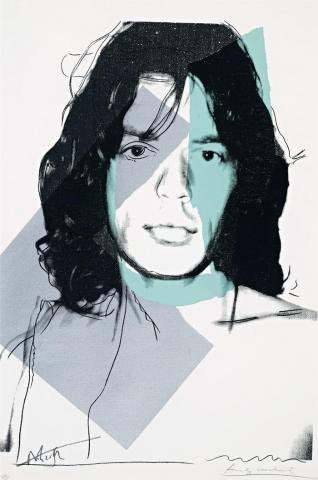MICK JAGGER, 1975
Andy Warhol
colour screenprint (from a portfolio of ten)
110.5 x 74.0 cm
signed lower right: Andy Warhol
signed lower left: Mick Jagger
Published by Seabird Editions, London
Private collection, Melbourne
Feldman, F., and Schellmann, J., Andy Warhol Prints: A Catalogue Raisonne 1962–1987, Ronald Feldman Fine Arts, New York, 1997, cat. II.138, p. 88 (illus. another example)
'If you want to know who we were, just look at the surface of Andy's prints- for there we are.'1
Influential exponent of Pop Art and icon of twentieth century art generally, Andy Warhol remains without doubt most universally acclaimed for his monumental duplicated images of mass 'consumerism' and particularly, his multiple 'heroic' portraits of personalities such as Marilyn Monroe, Elvis Presley and Elizabeth Taylor. Celebrating both the famous and infamous from spheres as diverse as sport, politics and television, Warhol not only encapsulated the dreams and desires of an entire nation but, arguably more than any other artist of his generation, revitalised the practice of portraiture, drawing renewed attention to it within the milieu of the American avant-garde. Significantly however, where during the sixties the young artist had employed the genre as a deliberate reaction to the prevailing predilection for abstraction, by the following decade, his own public recognition had escalated so dramatically that such portraits were frequently executed as commissions for celebrities who sought the cache of being immortalised by Warhol.
Warhol first met Mick Jagger in 1963 'at a time when the Rolling Stones were not yet widely known in the United States' and subsequently designed the provocative cover for the band's 'Sticky Fingers' album. Both the image and the album proved an enormous success, leaving the shamelessly commercial artist to publicly lament that he had not been paid enough given the millions of copies sold. Accordingly, when Warhol revisited the subject over a decade later in the present print, it was no doubt partially with an eye for financial gain, for Jagger was now not only a feted member of the New York club scene, but had assumed legendary status internationally.
Notably, in stark contrast to earlier suites such as Flash - November 22, 1963 (a 1968 portfolio of prints which extended his interest in the assassination of President John F. Kennedy, featuring news photos capturing the event), Warhol no longer relies upon appropriated images made 'public' by virtue of their appearance in the media, but rather employs photographs he himself has taken - a technique hitherto unprecedented within the artist's oeuvre. In addition, the present portrait departs from Warhol's graphics of the previous decade in the novel introduction into the silkscreen process of torn paper collage and superimposed drawing - motifs which, inspired by the cut-outs of Matisse and Leger, would culminate in the most conceptually and aesthetically sophisticated prints of his entire career.
1. Danto, A., 'Warhol and the Politics of Prints' in Feldman, F., and Schellmann, J., Andy Warhol Prints: A Catalogue raisonné 1962-1987, Ronald Feldman Fine Arts, New York, 1997, p. 15
VERONICA ANGELATOS
